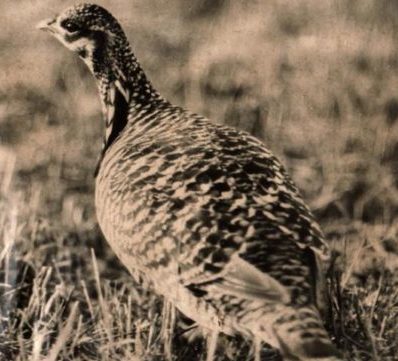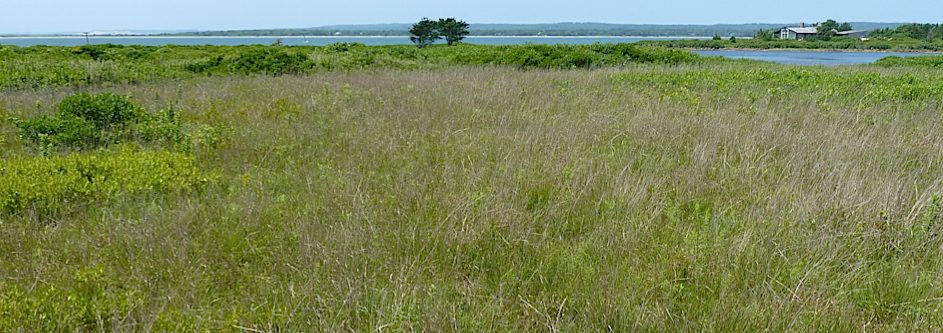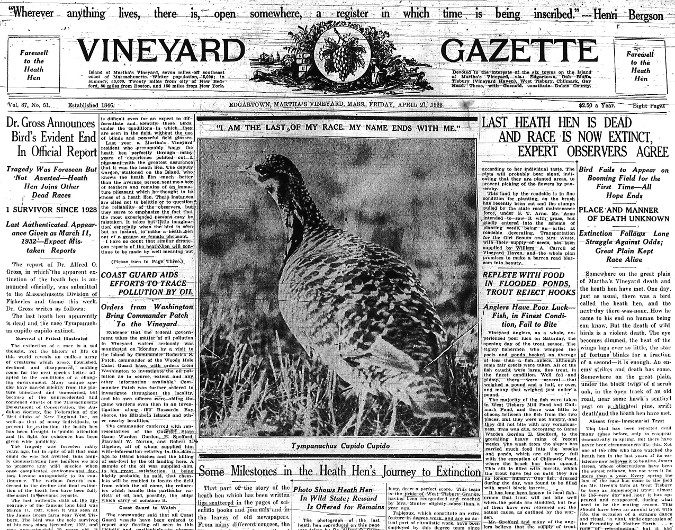The Heath Hen is an extinct species within the Prairie Chicken Tympanuchus genus, including the extant Greater Prairie Chicken, Lesser Prairie Chicken, and Sharp-tailed Grouse. Heath Hens were once abundant throughout New England, inhabiting sandy scrub-oak plains and sandplain grasslands interspersed throughout the deciduous forests of northeastern states from Virginia to Maine.
ABOUT THE HEATH HEN

History and Ecology

A current sandplain on the Island that is ideal Heath Hen habitat. Photo credit: Stewart Brand.
The birds were so tasty and easy to shoot that they were hunted to extinction on the mainland by 1870. One last flock survived on Martha’s Vineyard for 60 years because Islanders embraced a new form of conservation known as habitat preservation. What is now the State Forest was originally set aside and protected as Heath Hen habitat, and the birds were defended against hunters and predators.
The remnant population on Martha’s Vineyard seemed to thrive under protection, growing from just a hundred or so birds to a flock of ~2,000 by 1916, when disaster struck. The value and necessity of wildfires to maintain an open meadow-patchwork structure of sandplain grasslands was not fully understood or appreciated at the time. Land managers worked to prevent fires on the reserve, leading to a large accumulation of combustible fuel. In 1916 an intense fire raged across the reserve, killing hundreds of birds. In 1917 less than a hundred birds inhabited the island once again. The flock began to recuperate, growing to 500 birds. However, a skewed sex ratio and the inbreeding effects of two bottlenecks, set just a few generations apart, took their toll. The flock failed to reproduce, declining precipitously in the following years.
The Death of Booming Ben, the last Heath Hen
In the 1920s the Island became famous for its beloved, dwindling flock. When the last Heath Hen, known as Booming Ben, died in 1932, the sense of tragedy was widespread. In the Vineyard Gazette, Henry Beetle Hough wrote this defining statement about extinction:
“There is no survivor, there is no future, there is no life to be recreated in this form again. We are looking upon the uttermost finality which can be written, glimpsing the darkness which will not know another ray of light. We are in touch with the reality of extinction.”
That last chapter in the Heath Hen saga helped galvanize the burgeoning conservation movement of the 20th century. But what if that was not the last chapter, and Martha’s Vineyard can take up the story where it left off and demonstrate a revolutionary new set of goals and tools for conservation? It is possible the Heath Hen could be the first true de-extinction success from the drawing board to booming birds on the landscape. The next chapter of the Heath Hen’s story could be one of renewed conservation inspiration, as its de-extinction leads innovation for genetic rescue for birds and spurs public interest in habitat restoration throughout New England.
Heath Hen Natural History
Long-extinct heath hen comes to life in archival film
Heath Hen Resources
Natural History
- Edey, Maitland A. The Last Stand of the Heath Hen. The Intelligencer. Dukes County Historical Society. May 1998: 155-173
- Forbush, Edward Howe. The Heath Hen of Martha’s Vineyard. The American Museum Journal. 278-285.
- Hough, H. The Heath Hen’s Journey to Extinction 1792-1933. Dukes County Historical Society. ~1933.
- Keniston, Allan. The Last Years of the Heath Hen. The Intelligencer. Dukes County Historical Society. 282-287.
Genomic Science
- Hammerly, Susan, et. al. A comparison of pedigree- and DNA-based measures for identifying inbreeding depression in the critically endangered Attwater’s Prairie-chicken. Molecular Ecology. Vol. 22, 5313–5328. 2013.
- Johnson, Jeff A, et. al. Low genetic variation in the Heath Hen prior to extinction and implications for the conservation of prairie-chicken population. Conservation Genetics. Vol. 7, 37–48. 2006.
- Palkovac, Eric P, et. al. Genetic evaluation of a proposed introduction: the case of the greater prairie chicken and the extinct heath hen. Molecular Ecology. Vol. 13, 1759–1769, 2004.
- Westemeier, Ronald, et. al. Tracking the Long-Term Decline and Recovery of an Isolated Population. Science. Vol. 282, 1695 (1998).
- Wang, Biao. Whole genome sequencing of the black grouse (Tetrao tetrix): reference guided assembly suggests faster-Z and MHC evolution. BMC Genomics. 15:180, 2014.
Heath Hen Oral Histories
The Martha’s Vineyard Museum Oral History Center promotes the preservation and collection of Vineyard history, past and present, through recorded oral history interviews and related materials. Oral histories involving the heath hen have been carefully selected from the collection for the July 24 Heath Hen event. An oral history by Hollis Smith is shown below.




